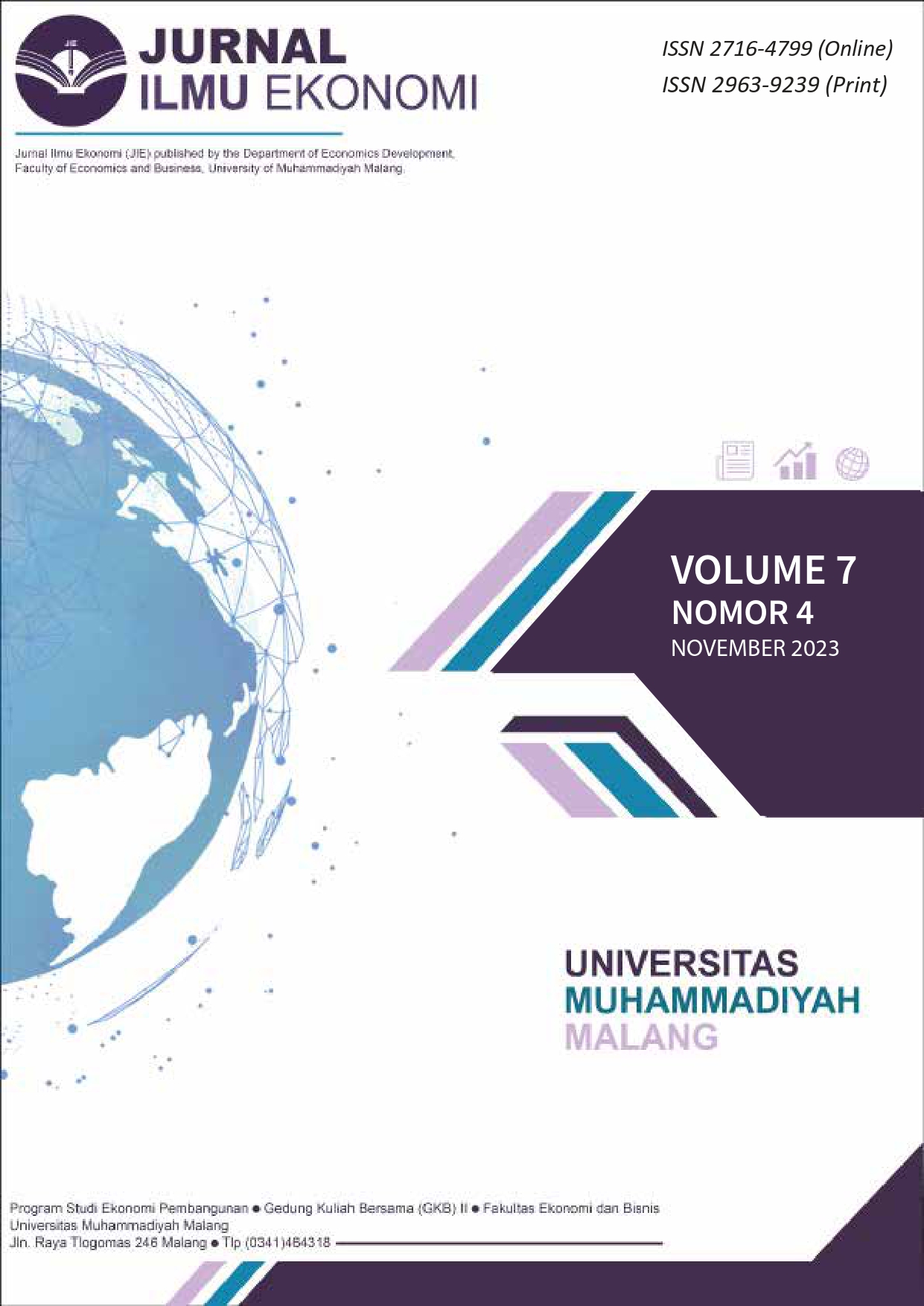Analisis Daya Saing dan Inovasi Terhadap Pertumbuhan Ekonomi Indonesia Tahun 2016-2020
DOI:
https://doi.org/10.22219/jie.v7i04.30151Keywords:
Competitiveness, Innovation, Economic GrowthAbstract
This research aims to analyze the competitiveness and innovation on economic growth in Indonesia. The data used in this research is secondary data. The data analysis method used is multiple linear regression analysis in 34 Indonesian provinces from 2016 - 2020. The results of the research show that from processing the t test the competitiveness does not have a significant and positive effect on economic growth. Meanwhile, innovation has a significant and positive effect on economic growth. And the results of the simultaneous F test processing can be concluded that the competitiveness index and innovation simultaneously have a significant positive effect on economic growth.
Penelitian ini bertujuan untuk menganalisis daya saing dan inovasi terhadap pertumbuhan ekonomi di Indonesia. Data yang digunakan dalam penelitian ini adalah data sekunder. Metode analisis data yang digunakan yaitu analisis regresi linier berganda di 34 Provinsi Indonesia dari tahun 2016 – 2020. Hasil penelitian menunjukan bahwa dari pengolahan uji t daya saing tidak berpengaruh signifikan dan positif terhadap pertumbuhan ekonomi. Sedangkan inovasi berpengaruh signifikan dan positif terhadap pertumbuhan ekonomi. Dan hasil dari pengolahan uji F simultan maka dapat di simpulkan bahwa indeks daya saing dan inovasi secara simultan berpengaruh positif signifikan dan terhadap pertumbuhan ekonomi.
Downloads
References
Briliansyah, I. (2019). Pengaruh Daya Saing Ekspor Karet. Universitas Sriwijaya.
D’Cruz J dan A. Rugman, A. (1992). New Concepts for Canadian Competitiveness. Kodak Canada.
Adianugraha, F. Y. (2017). Analisis Potensi dan Daya Saing Ekonomi Kota Malang Provinsi Jawa Timur 2011-2015. Universitas Brawijaya.
Freeman, R. R., Bucksbaum, P. H., Milchberg, H., Darack, S., Schumacher, D., & Geusic, M. E. (1987). Above-threshold ionization with subpicosecond laser pulses. Physical Review Letters, 59(10), 1092–1095. https://doi.org/10.1103/PhysRevLett.59.1092
Korez-Vide, R., & Tominc, P. (2016). Competitiveness, Entrepreneurship and Economic Growth. In Competitiveness of CEE Economies and Businesses: Multidisciplinary Perspectives on Challenges and Opportunities. Springer International Publishing. https://doi.org/10.1007/978-3-319-39654-5_2
LeBel, P. (2008). The Role of Creative Innovation in Economic Growth: Some International Comparisons. Journal of Asian Economics, 19(4), 334–347.
Mihaela, S. (2016). Competitiveness and Economic Growth in Romanian Regions. Journal of Competitiveness, 8(4), 46–60. https://doi.org/10.7441/joc.2016.04.03
Murtha, T. P., & Lenway, S. A. (2007). Country capabilities and the strategic state: How national political institutions affect multinational Corporations’ Strategies. Strategic Management Journal, 15(S2), 113–129. https://doi.org/10.1002/smj.4250151008
P Kiranta, F., & Meydianawathi, L. G. (2007). Analisis Tingkat Daya Saing Ekspor Biji Kakao Indonesia Tahun 2007-2012. E-Jurnal EP Unud, 3(11), 502–512.
Prasetyo, Bangun, R., & Firdaus, M. (2009). Pengaruh Infrastruktur Pada Pertumbuhan Ekonomi Wilayah di Indonesia. Jurnal Ekonomi Dan Kebijakan Pembangunan , 2(9), 222–236.
Romer, P. M. (1986). Increasing Returns and Long-Run Growth. Journal of Political Economy, 9(5), 1002–1037.
Setioputri, P. (2020). Pengaruh Inovasi Terhadap Pertumbuhan Ekonomi Analisis Data Global. Universitas Airlangga.
Solow, R. M. (1956). A Contribution to The Theory of Economic Growth. The Quarterly Journal of Economics, 70(1), 65–94.
Xavier Sala-I-Martin. (2008). The Global Competitiveness Index: Prioritizing the Economic Policy Agenda.
Yao, L., Maneejuk, P., Yamaka, W., & Liu, J. (2023). Quantifying the Competitiveness of Cultural Industry and Its Impacts on Chinese Economic Growth. Sustainability (Switzerland), 15(79), 1–19. https://doi.org/10.3390/su15010079
Downloads
Published
How to Cite
Issue
Section
License
Copyright (c) 2023 Lailisholawati, L

This work is licensed under a Creative Commons Attribution-NonCommercial-ShareAlike 4.0 International License.
Authors who publish with this journal agree to the following terms:
- For all articles published in the JIE (Jurnal Ilmu Ekonomi), copyright is retained by the authors. Authors give permission to the publisher to announce the work with conditions. When the manuscript is accepted for publication, the authors agree to the automatic transfer of non-exclusive publishing rights to the publisher.
- Authors retain copyright and grant the journal right of first publication with the work simultaneously licensed under a Creative Commons Attribution-NonCommercial-ShareAlike 4.0 International License that allows others to share the work with an acknowledgement of the work's authorship and initial publication in this journal.
- Authors are able to enter into separate, additional contractual arrangements for the non-exclusive distribution of the journal's published version of the work (e.g., post it to an institutional repository or publish it in a book), with an acknowledgement of its initial publication in this journal.
- Authors are permitted and encouraged to post their work online (e.g., in institutional repositories or on their website) prior to and during the submission process, as it can lead to productive exchanges, as well as earlier and greater citation of published work (See The Effect of Open Access).
This is an open access article and licensed under a Creative Commons Attribution-NonCommercial-ShareAlike 4.0 International License








